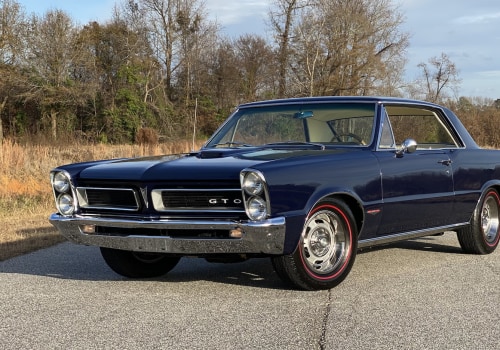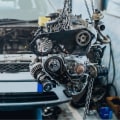Are you a car enthusiast looking to take on the challenge of restoring a Pontiac? If so, you're not alone. The process of bringing an old, beloved car back to its former glory is one filled with both challenges and successes. In this article, we will delve into the world of Pontiac car restoration, where we will explore the joys and struggles that come with restoring this iconic vehicle. From finding the perfect project car to navigating through difficult repairs and upgrades, we will cover it all.
So sit back, buckle up, and get ready to learn about the challenges and successes in restoring a Pontiac. Pontiac cars hold a special place in the hearts of many car enthusiasts. Founded in 1926, Pontiac was known for its stylish and performance-driven vehicles. Over the years, they produced a variety of models that became iconic in the automotive industry. When it comes to restoring a Pontiac, the first step is to choose which model to work on.
Each model has its own unique features and challenges, making the restoration process a truly individual experience. One popular model for restoration is the Pontiac GTO, considered by many as the first muscle car. This iconic vehicle was first introduced in 1964 and quickly gained popularity for its powerful engine and sleek design. Restoring a GTO can be a challenging but rewarding experience, as finding original parts can be difficult.
Another beloved model is the Pontiac Firebird, known for its distinctive look and impressive performance. With various editions and options available, restoring a Firebird offers endless opportunities for customization and personalization. Now, let's talk about the challenges that come with restoring a Pontiac. One of the biggest obstacles is finding rare parts, especially for older models.
As Pontiac is no longer in production, many parts are no longer available from dealerships. This means that restorers often have to search through salvage yards or connect with other enthusiasts to find the necessary parts. Rust is also a common issue when restoring a Pontiac, especially for models that have been sitting in storage for a long time. Dealing with rust can be time-consuming and costly, but it's a necessary step to ensure the longevity of your restored Pontiac.
But don't let these challenges discourage you, as there are plenty of success stories from experienced restorers to inspire you. Many have found creative solutions to finding rare parts or have mastered the art of repairing rusted areas. It's all about perseverance and a love for the Pontiac brand. To help you on your restoration journey, there are various resources available for connecting with other Pontiac enthusiasts.
Online forums and social media groups are great places to exchange tips and advice, as well as showcase your progress. You can also attend car events and shows, where you can meet fellow Pontiac lovers and show off your restored car. In conclusion, restoring a Pontiac is a challenging but rewarding experience. Each model has its own unique features and challenges, making the process truly individual.
With determination, creativity, and a love for the brand, you can overcome any obstacle and restore your beloved Pontiac to its former glory.
Success Stories and Tips
Are you feeling overwhelmed by the thought of restoring your Pontiac? Look no further! We have gathered success stories and tips from experienced restorers to help guide you through the process. These individuals have faced similar challenges and have come out on top, with a beautifully restored Pontiac to show for it. Let their stories inspire you and their tips guide you towards a successful restoration.Challenges of Restoring a Pontiac
If you're planning on restoring a Pontiac, you should be prepared to face some challenges along the way. The first and perhaps most obvious challenge is finding the necessary parts for your specific model.As Pontiacs are no longer in production, parts can be difficult to come by. You may have to search through junkyards, online forums, or even reach out to other enthusiasts for help. Another challenge you may face is the cost of restoration. Depending on the condition of your Pontiac and the extent of restoration needed, it can be quite expensive. It's important to set a budget and be prepared for unexpected expenses along the way. The restoration process itself can also be a challenge.
If you are not experienced in car restoration, you may encounter difficulties with certain tasks such as welding or engine rebuilding. It's important to do thorough research and seek guidance from experienced individuals.
The History of Pontiac Cars
The history of Pontiac cars dates back to the early 1900s, when the Pontiac Buggy Company began producing horse-drawn carriages. In 1907, the company shifted its focus to automobiles, with the first Pontiac car being released in 1926. The brand quickly gained popularity for its affordable yet stylish cars, and by the 1930s, Pontiac was one of the top-selling brands in the United States. Throughout the decades, Pontiac continued to innovate and introduce new models, including the iconic GTO in the 1960s and the Firebird in the 1970s. These models solidified Pontiac's reputation as a manufacturer of high-performance and muscle cars. However, by the late 2000s, Pontiac faced financial troubles and saw a decline in sales.In 2009, General Motors announced that it would be discontinuing the brand, marking the end of an era for Pontiac cars. Despite this, Pontiac remains a beloved and iconic brand among car enthusiasts, with many dedicated fans still restoring and preserving these classic cars. The history of Pontiac cars is a testament to their enduring legacy and impact on the automotive industry.
Connecting with Other Enthusiasts
One of the most important aspects of restoring a Pontiac is connecting with other enthusiasts. Not only can they provide valuable tips and advice, but they can also offer a sense of community and support throughout your restoration journey. There are many ways to find and connect with other Pontiac enthusiasts.One option is to join online forums or social media groups dedicated to Pontiac car restoration. These platforms allow you to connect with people who share your passion and can offer helpful insights on where to find parts, how to troubleshoot common issues, and more. Another great resource for connecting with other enthusiasts is attending car shows and events specifically for Pontiacs. These gatherings not only give you the opportunity to see beautifully restored cars, but also allow you to network and make connections with fellow enthusiasts.
Additionally, consider joining a local Pontiac club or organization. These groups often hold meetings, events, and workshops related to car restoration, providing a great opportunity to meet and connect with others who share your interest. By connecting with other enthusiasts, you not only gain valuable resources for your restoration project, but also become part of a supportive and passionate community.
Attending Pontiac Car Events
One of the most exciting parts of restoring a Pontiac is being able to showcase your hard work and connect with other enthusiasts at car events. These events are a great opportunity to display your restored Pontiac and receive recognition for your efforts.It's also a chance to meet other Pontiac enthusiasts and share stories, tips, and ideas. There are many different types of car events that cater specifically to Pontiac owners. From local car shows to national conventions, there is always an event happening that you can attend. These events often include activities such as car displays, races, auctions, and workshops. Attending car events not only allows you to showcase your restored Pontiac, but it also gives you the opportunity to learn more about the restoration process. You can talk to other enthusiasts about their experiences and gain valuable knowledge and advice for future restoration projects. Connecting with other Pontiac enthusiasts at these events is also a great way to expand your network.
You may find new sources for parts or even potential restoration partners. It's always beneficial to have a community of people who share your passion for Pontiacs and can offer support and guidance. So next time you finish restoring your Pontiac, don't hesitate to attend a car event and show off your hard work. It's a great way to celebrate your success and be part of a community that shares your love for Pontiac cars.
Models of Pontiac Cars
When it comes to restoring a Pontiac, it's important to know the different models that exist. Each model has its own unique features and history, making the restoration process even more exciting. The first model to be introduced by Pontiac was the Series 6-27 in 1926, which was a six-cylinder car that quickly gained popularity among consumers.This was followed by the iconic Silver Streak in 1935, known for its sleek design and powerful engine. Other notable models include the Bonneville, Firebird, and GTO, each with their own loyal fan base and distinct characteristics. One of the biggest challenges in restoring a Pontiac is finding the right parts for each specific model. With so many different models produced over the years, some parts may be harder to come by than others. This is where connecting with other enthusiasts can be extremely beneficial.
By networking and sharing resources, you can increase your chances of finding the necessary parts for your specific Pontiac model. Another factor to consider when restoring a Pontiac is the level of customization you want to incorporate. Some models may have more options for customization, while others may have limited options. It's important to research and understand the capabilities and limitations of each model before beginning your restoration project. Restoring a Pontiac is no easy task, but with the right knowledge and resources, it can be a fulfilling and rewarding experience. We hope this article has provided you with valuable insights and inspiration for your restoration project.
Remember, the challenges may be great, but the end result of a beautifully restored Pontiac is worth it all.










